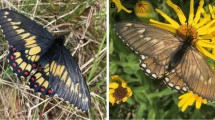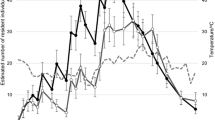Abstract
Birds are believed to be one of the principal predators of butterflies. The beak marks (BMs) left on the butterfly wings are useful indices of bird predation. We performed 84 collections in grasslands and woodlands during 2002–2006 in Ito, Shizuoka prefecture, and collected 893 specimens belonging to 48 species. In general, the larger was the body size the higher was the BM rate. There were two peaks in the BM rate and the peaks were higher by 13–14 % in autumn than in spring in both grasslands and woodlands. During 2007 and 2008, capture-mark-recapture surveys were conducted 82 times in a flight path of black swallowtail butterflies (BSBs). A total of 443 BSB were individually marked and released at a site 400 m away from the flight path after examining for BM, degree of wing damage, body size, sex and species. The BM% of BSB ranged from 40 to 46 %, which was the highest among the observed butterflies. The recapture rate was negatively correlated with the BM rate suggesting that the avian predation was strong enough to affect the survival rate of BSB adults. In addition, the BM rate showed a delayed positive response to BSB density in the previous month. Variation in the BM rate was analyzed with a multivariate model; it indicated that month and wing length were significant explanatory variables. In addition, the highest BM rate was observed at an intermediate wing size. These results strongly suggested that variation in the BM rate was caused by variation in avian life history and predator size. All the evidence suggested that an appreciable predation pressure by birds operated on BSB adult populations.







Similar content being viewed by others
References
Ban Y, Kiritani K, Miyai S, Nozato K (1990) Studies on ecology and behavior of Japanese black swallowtail butterflies. 8. Survivorship curves of adult male populations in Papilio helenus nicocicolens Butler and P. protenor dmetrius Cramer (Lepidoptera: Papilionidae). Appl Entomol Zool 25:409–414
Benson WW (1972) Natural selection for Miillerian mimicry in Heliconius erato in Costa Rica. Science 176:936–939
Bowers MD, Wiernasz DC (1979) Avian predation on the palatable butterfly, Cercyonis pegala (Satyridae). Ecol Entomol 4:205–209
Bowers MD, Brown I, Wheye D (1985) Bird predation as a selective agent in a butterfly population. Evolution 39:91–103
Brockwell PJ, Davis RA (2002) Introduction to time series and forecasting, 2nd edn. Springer, New York
Burger J, Gochfeld M (2001) Smooth-billed ani (Crotophaga ani) predation on butterflies in Mato Grosso, Brazil: risk decreases with increased group size. Behav Ecol Sociobiol 49:482–492
Calvert WH, Hedrick LE, Browert LP (1979) Mortality of the Monarch butterfly (Danasus plexippus L.): Avian predation at five overwintering sites in Mexico. Science 204:847–851
Carpenter GDH (1937) Further evidence that birds do attack and eat butterflies. Proc Zool Soc London A 107:223–247
Carpenter GDH (1941) The relative frequency of beak-marks on butterflies of different edibility to birds. Proc Zool Soc London (A) 111:223–231
Clarke C, Clarke FMM, Collins SC, Gill ACL, Turner JRG (1985) Male-like females, mimicry and transvestism in butterflies (Lepidoptera: Papilionidae). Systematic Entomol 10:257–283
Ehara S, Takahashi H, Homma T, Yamashita Y, Sakagami SF (1964) Spring activities of a Japanese black swallowtail, Papilio maackii tutanus Fenton at a flyway. Jap J Ecology 14:175–181
Gunnarsson B, Hake M (1999) Bird predation affects canopy-living arthropods in city parks. Can J Zool 77:1419–1428
Harvey AC (1993) Time series models, 2nd edn. Financial Times Prentice Hall, Upper Saddle River
Hasegawa H, Itô Y (1967) Biology of Hyphantria cunea Drury (Lepidoptera: Arctiidae) in Japan. 1. Notes on adult biology with reference to the predation by birds. Appl Entomol Zool 2:100–110
Hirose Y, Suzuki Y, Takagi M, Hiehata K, Yamasaki H, Kimoto H, Yamanaka M, Iga M, Yamaguchi K (1980) Population dynamics of the citrus swallowtail, Papilio xuthus L. (Lepidoptera: Papilionidae): mechanisms stabilizing its numbers. Res Popul Ecol 21:260–285
Ide J (2006) Sexual and seasonal differences in the frequency of beak marks on the wings of two Lethe butterflies. Ecol Res 21:453–459
Johki Y (1985) Wing damages of butterflies and birds’ attacks. Tyô to Ga 35:202–207
Kiritani K, Nozato K, Miyai S, Ban Y (1984) Studies on ecology and behavior of Japanese black swallowtail butterflies. 1. Ecological characteristics of male population in Papilio helenus nicconicolens Butler and P. protenor demetrius Cramer (Lepidoptera: Papilionidae). Appl Entomol Zool 19:509–517
Kitahara M, Fujii K (2003) Diversity and rarity hotspots and conservation of the butterfly communities in and around the Aokigahara woodland of Mount Fuji, central Japan. Ecol Res 18:503–522
Kuzu S (1933) Survey on food items of the tit. Report of surveys on birds and mammals, Forest Agency, MAF. No. 7, 35–122 (in Japanese)
Mallows CL (1973) Some comments on C p . Technometrics 15:661–675
Nakamura Y (2011) Conservation of butterflies in Japan: status, actions and strategy. J Insect Conserv 15:5–22
Nishida R, Fukami H (1989) Ecological adaptation of an Aristolochiaceae-feeding swallowtail butterfly, Atrophaneura alcinous, to aristolochic acids. J Chem Ecol 15:2549–2563
Nozato K, Kiritani K, Miyai S, Ban Y (1985) Studies on ecology and behavior of Japanese black swallowtail butterflies. IV Estimation of life span of male Papilio helenus nicconicolens Butler and P. protenor demetrius Cramer (Lepidoptera: Papilionidae). Appl Entomol Zool 20:494–496
Ohsaki N (1995) Preferential predation of female butterflies and the evolution of Batesian mimicry. Nature 378:173–175
Ohsaki N (2005) A common mechanism explaining the evolution of female-limited and both-sex Batesian mimicry in butterflies. J Appl Ecol 74:728–734
Rawlins JE, Lederhouse RC (1978) The influence of environmental factors on roosting in the Black Swallowtail, Papilio polyxenes asterias Stoll (Papilionidae). J Lepid Soc 32:145–159
Sakurai R (2011) Field observation of predation on adult lepidopterans by the tree sparrow Passer montanus saturatus. Entomol Sci 14:162–165
SAS Institute Inc. (2008) SAS/STAT® 9.2 user’s guide. SAS Institute Inc., Cary
Shapiro AM (1974) Beak-mark frequency as an index of seasonal predation intensity on common butterflies. Am Nat 108:229–232
Smetacek P (2006) Some distasteful Asian Papilioninae (Papilionidae). J Lepidopt Soc 60:82–85
Smith D (1979) The significance of beak marks on the wings of an aposematic, distasteful and polymorphic butterfly. Nature 281:215–216
Suzuki N, Matsumoto K (1992) Lifetime mating success of males in a natural population of the papilionid butterfly, Atrophaneura alcinous (Lepidoptera: Papilionidae). Res Popul Ecol 34:397–407
Suzuki N, Niizuma A, Yamashita K, Watanabe M, Nozato K, Ishida A, Kiritani K, Miyai S (1985) Studies on ecology and behavior of Japanese black swallowtail butterflies 2. Daily activity patterns and thermoregulation in summer generations of Papilio helenus nicconicolens Butler and P. protenor demetrius Cramer (Lepidoptera: Papilionidae). Jpn J Ecol 35:21–30
Suzuki N, Yamashita K, Niizuma A, Kiritani K (1987) Studies on ecology and behavior of Japanese black swallowtail butterflies, 6. Nectar feeding of Papilio helenus nicconicolens Butler and P. protenor demetrius Cramer as main pollinators of glory bower, Clerodendron trichotomum Thunb. Ecol Res 2:41–52
Tsubuki T, Ueda K (2001) Significance of beak marks on butterfly wings: a review in Japan. STRIX 19:129–140 (in Japanese with English abstract)
Uésugi K (1991) Temporal change in records of the mimetic butterfly Papilio polytes with establishment of its model Pachliopta aristolochiae in the Ryukyu Islands. Jpn J Entomol 59:183–198
Uésugi K (1996) The adaptive significance of Batesian mimicry in the swallowtail butterfly, Papilio polytes (Insecta, Papilionidae): associative learning in a predator. Ethology 102:762–775
Vandaele W (1983) Applied time series and Box-Jenkins models. Academic Press, New York
Watanabe M, Nozato K, Kiritani K, Miyai S (1984) Seasonal fluctuations of egg density and survival rate in Japanese black swallowtail butterflies, 2. Daily activity patterns and thermoregulation in summer generations of Papilio helenus nicconicolens Butler and P. protenor demetrius Cramer (Lepidoptera: Papilionidae). Jpn J Ecol 35:21–30
Watanabe M, Suzuki N, Nozato K, Kiritani K, Yamashita K, Niizuma A (1985) Studies on ecology and behavior of Japanese black swallowtail butterflies 3. Diurnal tracking behavior of adults in summer generation. Appl Entomol Zool 20:210–217
Watanabe M, Nozato K, Kiritani K (1986) Studies on ecology and behavior of Japanese black swallowtail butterflies (Lepidoptera: Papilionidae). 5. Fecundity in summer generations. Appl Entomol Zool 21:448–453
Watanabe M, Koizumi H, Suzuki N, Kiritani K (1988) Studies on ecology and behavior of Japanese black swallowtail butterflies 7. Nectar of glory tree, Clerodendron trichotomum, as a food resource of adults in summer. Ecol Res 3:175–180
Wiklund C, Sillėn-Tullberg B (1985) Why distasteful butterflies have aposematic larvae and adults, but cryptic pupae: evidence from predation experiments on the monarch and the European swallowtail. Evolution 39:1155–1158
Wourms MK, Wasserman FE (1985) Bird predation on Lepidoptera and the reliability of beak-marks in determining predation pressure. J Lepidopterists’ Soc 39:239–261
Yamashita H, Kiritani K (2008) Butterfly species assemblages as bioindicators of grassland and woodland environments. Annual Report of Interdisciplinary Research Institute of Environmental Sciences 27:59–67 (In Japanese with English summary)
Yamashita H, Kiritani K, Togashi K, Kubota K (2006) Wing dimorphism in three carabid species living in the grasslands of Mt. Omuro, Shizuoka, Japan. Appl Entomol Zool 41:463–470
Acknowledgments
We thank Prof. David Andow, Minnesota University for his useful comments and verbal corrections on our manuscript. We acknowledge the assistance of Dr. M. Tokuda, Saga University in preparing the study area map. Two anonymous reviewers gave many insightful comments and suggestions.
Author information
Authors and Affiliations
Corresponding author
Electronic supplementary material
Below is the link to the electronic supplementary material.
Rights and permissions
About this article
Cite this article
Kiritani, K., Yamashita, H. & Yamamura, K. Beak marks on butterfly wings with special reference to Japanese black swallowtail. Popul Ecol 55, 451–459 (2013). https://doi.org/10.1007/s10144-013-0375-4
Received:
Accepted:
Published:
Issue Date:
DOI: https://doi.org/10.1007/s10144-013-0375-4




